The Lebanese Christian village on the border with Israel that escapes the shelling: ‘This is safer than Beirut’
The young men of Rmeish recently expelled suspected Hezbollah militiamen who were preparing attacks against Israel, an incident that took on a national dimension
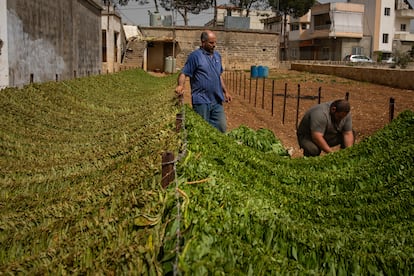

The road runs through southern Lebanon, parallel to Israel. It is dangerous to travel through the area: the Israeli army can open fire on those vehicles it suspects are being driven incognito by Hezbollah militiamen, the armed fundamentalist group with which it has been waging a kind of war of attrition since the beginning of the Israeli invasion of Gaza, a low-intensity conflict that has been increasing in scale without yet escalating into open confrontation. Every few miles, one sees houses destroyed by Israeli shelling and photos of martyrs that point to the weight of history in these lands: some are casualties of the crossfire with Israel in parallel to the offensive in the Gaza Strip (Hezbollah acknowledges more than 340 fighters killed); others, faded by time, date from the 1980s and 1990s, when Israel occupied southern Lebanon, involuntarily giving rise to the now powerful Shia party-militia.
Suddenly, in a matter of hundreds of meters, the yellow flags of Hezbollah and green flags of Amal (the other Shia faction), and messages in Arabic such as “Every Muslim must prepare to fight Israel” or “This Lebanon is the best weapon against Israel,” disappear. Mosques give way to churches and sculptures of the Virgin Mary and, of course, of the monk-hermit Saint Charbel, the patron saint of Lebanon who is omnipresent in the Maronite areas. The private school belongs to the Antonine sisters and the stores no longer bear names written in Arabic, such as Ali or Mohamed, but Chez George or Manucure Danielle, in French. Advertisements for arak (an aniseed liqueur typical of the region) and a winery bearing the name of the village (Domaine de Rmeich) remind us that alcohol is produced and drunk here.
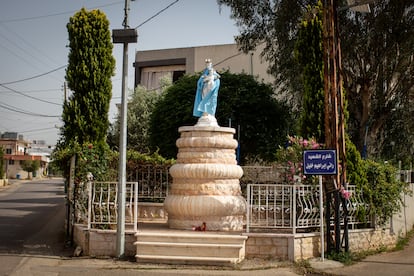
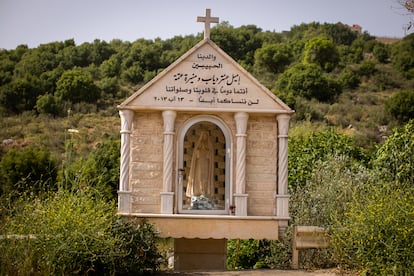
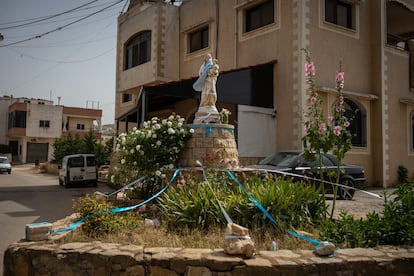
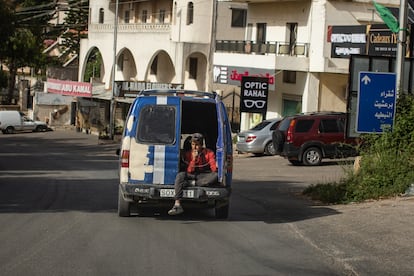
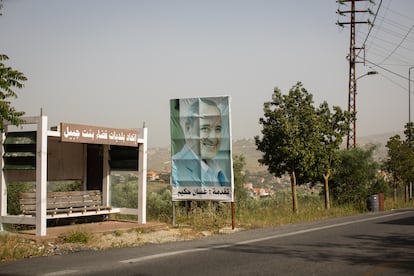
The village is called Rmeish (with various spellings), and had about 5,000 inhabitants before the conflict between Israel and Hezbollah flared up, and no one would say on a sunny June morning that their houses practically touch the Jewish State. Nor that the border forms a curve, placing the dividing line about two kilometers (1.2 miles) to its south, east and west.
Although stores are closed and around 1,000 families remain displaced by the war (mostly to the Christian neighborhoods in East Beirut), cars pass by quite frequently. Children can even be seen playing in the main square, dominated by a sculpture in homage to François el Hajj, a famous Lebanese general originally from the village who was killed in a car bombing in Beirut in 2007, shortly before he was expected to be promoted to Chief of the General Staff.
The sensation is strange. Drones and the roar of Israeli fighter-bombers can be heard in the background. There is also the occasional explosion, or a plume of smoke. But the people (both Lebanese and Syrian refugees still working here in agriculture) move about fearlessly. Some 400 families stayed or have returned, partly because of their crops (the men continue to dry tobacco leaves, key to the area’s economy), and partly because Beirut is much more expensive, explains Nimr Alam, a 45-year-old teacher. The problem is more about getting in or out of Rmeish. He himself avoids the roads most heavily bombed by Israeli aircraft when he goes to the capital to visit his family.
Wadia, 36, retains enough customers to keep his hair salon open in the square. “I didn’t close even on October 8. Nor on the 9th, nor on the 10th... This is safer than Beirut. The only thing I’m afraid of is that a party missile will fall here. The Israelis are more accurate. I don’t like the Israelis, obviously, but they are not a threat to me. There is no state here, only the party,” he says while blow-drying a customer’s hair.
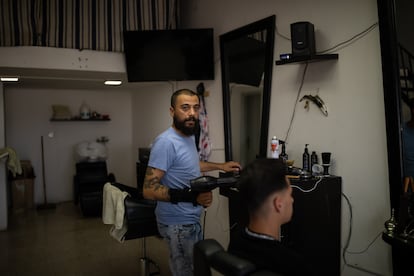
Wadia doesn’t need to specify which party he is referring to. It is the “Party of God,” the meaning of the word Hezbollah. He recounts that its militiamen “have thrown grenades from the surrounding forests and tried to sneak in” to Rmeish. “Once we village boys had to go out and tell them to leave,” he adds.
He is referring to an episode last March that gained national prominence. One morning, a local youth identified two unknown cars driving near the village school. He approached the vehicles, concluded that they contained Hezbollah members about to plant an anti-tank missile launcher, and alerted the others. The young men gathered to chase them away and the argument ended with the suspected militiamen firing into the air to drive them off, and the Rmeish youngsters ringing the church bells to alert the rest of the village.
The leader of the Christian Phalanges, Sami Gemayel, was quick to speak out: “Full solidarity with our people in Rmeish,” wrote the nephew of Bachir Pierre Gemayel, the president-elect whose assassination in 1982 led to the notorious massacre of Palestinians and Shiites in Sabra and Chatila, with then-Israeli defense minister Ariel Sharon “indirectly responsible” for looking the other way and continuing to shine a light on the area, as determined by an Israeli commission of inquiry.
“They have known since [the Israel-Hezbollah War of] 2006 that we are people of peace. We don’t even know how to shoot. We have told them not to come in here. We have gone to their homes to politely tell them to let us live in peace, quietly. Generally, they have accepted, but some have tried and we have thrown them out,” says Nayib El Amil, the priest everyone here calls père (father), a legacy of the French colonial mandate (1920-1943), when Lebanon gained independence and the Maronites enjoyed a privileged position. Aware that few forget the alliance between Israel and the Maronite phalanxes during the occupation of southern Lebanon, El Amil challenges Hezbollah “to find a single Christian who has been a traitor since 2000.″ That is when Israel withdrew its last troops and brought in its local allies during the occupation. His life would have been in danger had he stayed in Lebanon.
Hezbollah issued a statement to vehemently deny “the false and malicious news” that “the Islamic Resistance attempted to fire rockets at the Zionist enemy from inside the town of Rmeish, or near the school or the town in general.” The party also insisted that its fighters only open fire from unpopulated areas, so as not to put civilians at risk.
Whether it was genuine or a misunderstanding, the incident reopened many wounds that had more or less healed. In 2022, Green Without Borders (an environmental NGO accused of being a front for Hezbollah) set up a structure near the village. The residents were furious and even the Maronite patriarch, Bechara Boutros Al Rai, intervened to dismantle it.
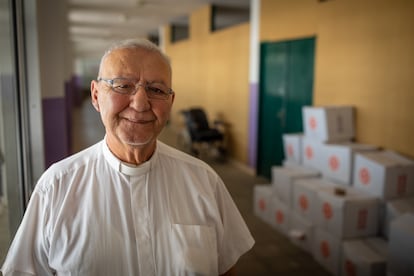

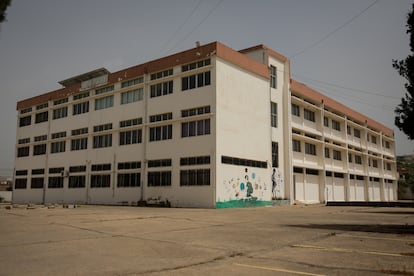
With a confessionalism structure that doomed any idea of shared citizenship to failure, Lebanon bled to death during 15 years of civil war (1975-1990). Today, after decades of shifting and seemingly unnatural alliances, it is politically divided into two major blocs, especially regarding its position on the power of Hezbollah. Since 2022, these remain without consensus as to which Christian leader should occupy the presidency, a vacant post that elects the prime minister, whose term has also expired and which is currently occupied on an interim basis by the Sunni Muslim Najib Mikati.
Just like the presidential seat, the public school is empty. As are all the schools in southern Lebanon, where the war has displaced 94,000 people and classes have been suspended for security reasons. Its 185 primary and technical students follow them as best they can via videoconference.
A dozen hospital beds now occupy one of the classrooms. There are also boxes containing medicines and basic medical supplies. It is an apprenticeship from the 2006 war, which began when Hezbollah launched a deadly surprise ambush against a military patrol in Israel (after six years of tension over the disputed Shebaa Farms) and Israel responded by invading the area. Up to 20,000 displaced people ended up in the locality, divided between the convent, the school and private homes, recalls Alam, one of those responsible for the fact that the school has looked like a field hospital since October 8, but which they have not yet had to use. “At that time, the Israelis bombed many roads, so many health workers could not reach the places where they were needed. We learned that wars start by surprise and you have to be prepared,” he says, with a crucifix around his neck and a tattoo that reads: “Thy will be done.”
Although the inhabitants of Rmeish have not joined the fighting, the consequences have finally reached them. The situation has been escalating dangerously for days: on June 11, the Israeli army killed the highest-ranking Hezbollah commander, Taleb Abdala, in the eight months of fighting; the militia retaliated with its largest wave of missiles to date: 215. Israel has been shelling intensively for days, including with white phosphorus (as several human rights NGOs have proven) and fire-generating rounds. Hezbollah has been deploying explosive drones, sparking blazes on the other side of the border. Last Wednesday, fires began engulfing olive groves and tobacco plantations belonging to families in Rmeish, which they had barely been able to grow or harvest due to Israeli shelling. The village remains safe. The surrounding area is not.
Sign up for our weekly newsletter to get more English-language news coverage from EL PAÍS USA Edition
Tu suscripción se está usando en otro dispositivo
¿Quieres añadir otro usuario a tu suscripción?
Si continúas leyendo en este dispositivo, no se podrá leer en el otro.
FlechaTu suscripción se está usando en otro dispositivo y solo puedes acceder a EL PAÍS desde un dispositivo a la vez.
Si quieres compartir tu cuenta, cambia tu suscripción a la modalidad Premium, así podrás añadir otro usuario. Cada uno accederá con su propia cuenta de email, lo que os permitirá personalizar vuestra experiencia en EL PAÍS.
¿Tienes una suscripción de empresa? Accede aquí para contratar más cuentas.
En el caso de no saber quién está usando tu cuenta, te recomendamos cambiar tu contraseña aquí.
Si decides continuar compartiendo tu cuenta, este mensaje se mostrará en tu dispositivo y en el de la otra persona que está usando tu cuenta de forma indefinida, afectando a tu experiencia de lectura. Puedes consultar aquí los términos y condiciones de la suscripción digital.
More information
Archived In
Últimas noticias
Maduro pleads not guilty before the federal court in New York: ‘I am still the president of Venezuela’
A new test can detect Alzheimer’s from a finger prick
UN team enters Sudanese city of El Fasher after paramilitary massacre: ‘It’s like a ghost town’
A recipe for resistance: Indigenous peoples politicize their struggles from the kitchen
Most viewed
- Gilles Lipovetsky: ‘If you want to live better and fall in love, take Prozac, don’t look to philosophy’
- Alain Aspect, Nobel laureate in physics: ‘Einstein was so smart that he would have had to recognize quantum entanglement’
- Alvin Hellerstein, a 92-year-old judge appointed by Bill Clinton, to preside over Maduro’s trial in New York
- Why oil has been at the center of Venezuela-US conflicts for decades
- Maduro’s downfall puts China’s relationship with Venezuela to the test










































